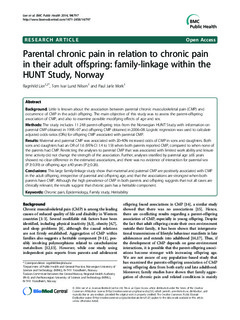| dc.contributor.author | Lier, Ragnhild | |
| dc.contributor.author | Nilsen, Tom Ivar Lund | |
| dc.contributor.author | Mork, Paul Jarle | |
| dc.date.accessioned | 2015-09-11T12:41:12Z | |
| dc.date.accessioned | 2015-09-30T08:25:00Z | |
| dc.date.available | 2015-09-11T12:41:12Z | |
| dc.date.available | 2015-09-30T08:25:00Z | |
| dc.date.issued | 2014 | |
| dc.identifier.citation | BMC Public Health 2014, 14(1) | nb_NO |
| dc.identifier.issn | 1471-2458 | |
| dc.identifier.uri | http://hdl.handle.net/11250/1104683 | |
| dc.description.abstract | Background: Little is known about the association between parental chronic musculoskeletal pain (CMP) and
occurrence of CMP in the adult offspring. The main objective of this study was to assess the parent-offspring
association of CMP, and also to examine possible modifying effects of age and sex.
Methods: The study includes 11 248 parent-offspring trios from the Norwegian HUNT Study with information on
parental CMP obtained in 1995–97 and offspring CMP obtained in 2006–08. Logistic regression was used to calculate
adjusted odds ratios (ORs) for offspring CMP associated with parental CMP.
Results: Maternal and paternal CMP was associated with 20-40% increased odds of CMP in sons and daughters. Both
sons and daughters had an OR of 1.6 (95% CI 1.4 to 1.9) when both parents reported CMP, compared to when none of
the parents had CMP. Restricting the analyses to parental CMP that was associated with limited work ability and leisure
time activity did not change the strength of the association. Further, analyses stratified by parental age ±65 years
showed no clear difference in the estimated associations, and there was no evidence of interaction for parental sex
(P ≥ 0.39) or offspring age ±40 years (P ≥ 0.26).
Conclusions: This large family-linkage study show that maternal and paternal CMP are positively associated with CMP
in the adult offspring, irrespective of parental and offspring age, and that the associations are strongest when both
parents have CMP. Although the high prevalence of CMP in both parents and offspring suggests that not all cases are
clinically relevant, the results suggest that chronic pain has a heritable component. | nb_NO |
| dc.language.iso | eng | nb_NO |
| dc.publisher | BioMed Central | nb_NO |
| dc.rights | Navngivelse-IngenBearbeidelse 3.0 Norge | * |
| dc.title | Parental chronic pain in relation to chronic pain in their adult offspring: Family-linkage within the HUNT Study, Norway | nb_NO |
| dc.type | Journal article | nb_NO |
| dc.type | Peer reviewed | en_GB |
| dc.date.updated | 2015-09-11T12:41:12Z | |
| dc.source.volume | 14 | nb_NO |
| dc.source.journal | BMC Public Health | nb_NO |
| dc.source.issue | 1 | nb_NO |
| dc.identifier.doi | 10.1186/1471-2458-14-797 | |
| dc.identifier.cristin | 1167315 | |
| dc.description.localcode | © 2014 Lier et al.; licensee BioMed Central Ltd. This is an Open Access article distributed under the terms of the Creative Commons Attribution License (http://creativecommons.org/licenses/by/2.0), which permits unrestricted use, distribution, and reproduction in any medium, provided the original work is properly credited. The Creative Commons Public Domain Dedication waiver (http://creativecommons.org/publicdomain/zero/1.0/) applies to the data made available in this article, unless otherwise stated. | nb_NO |
